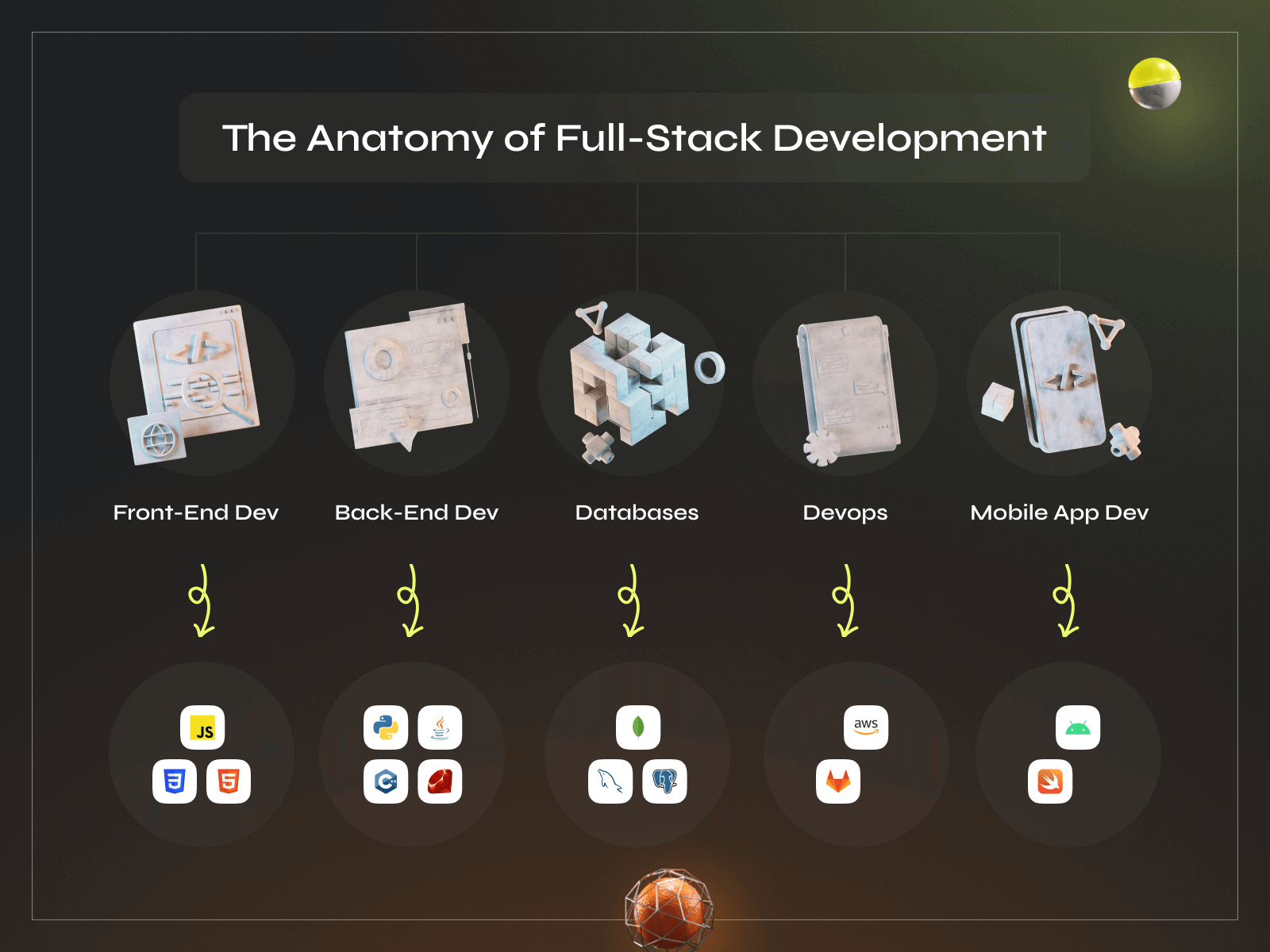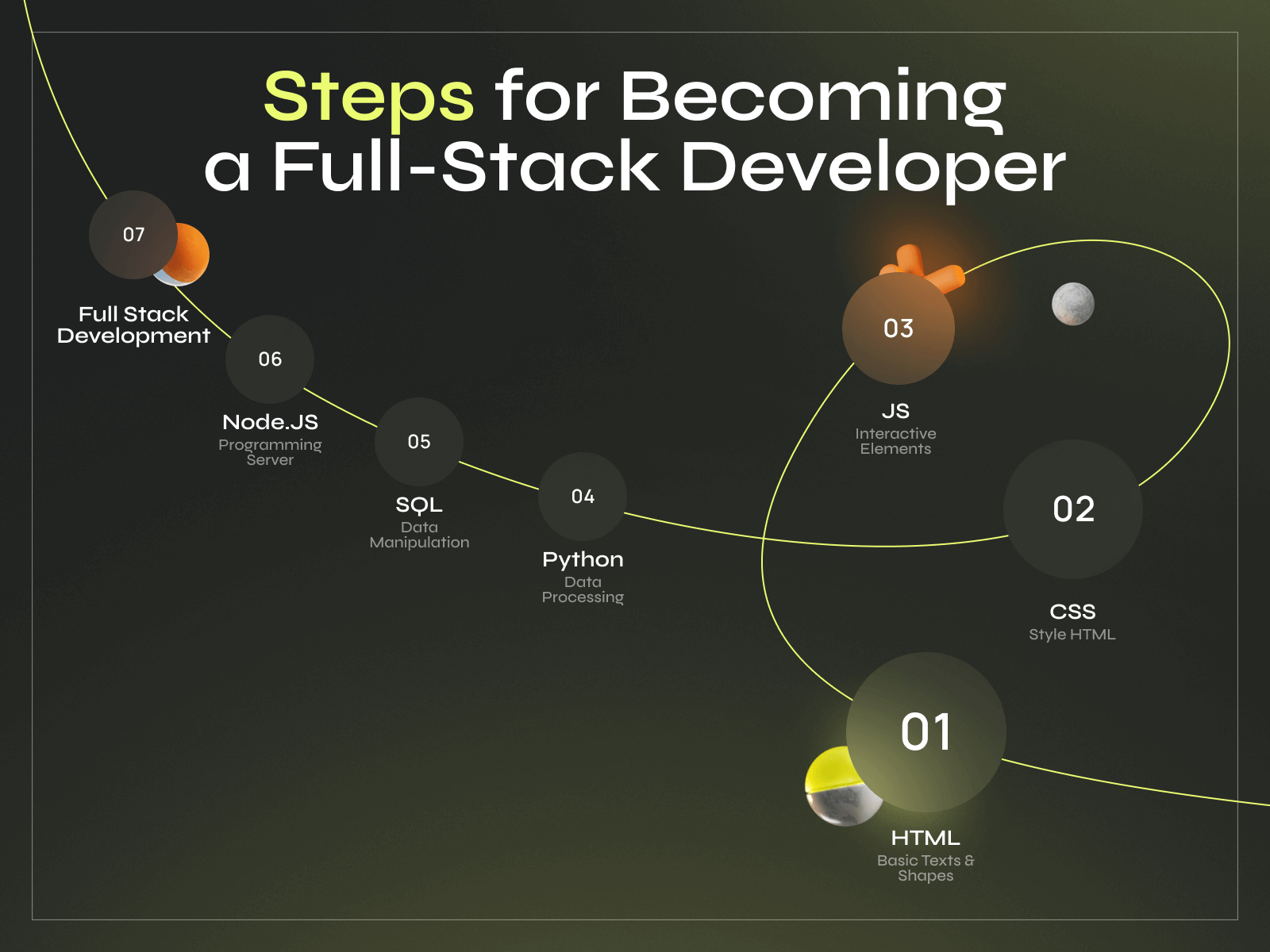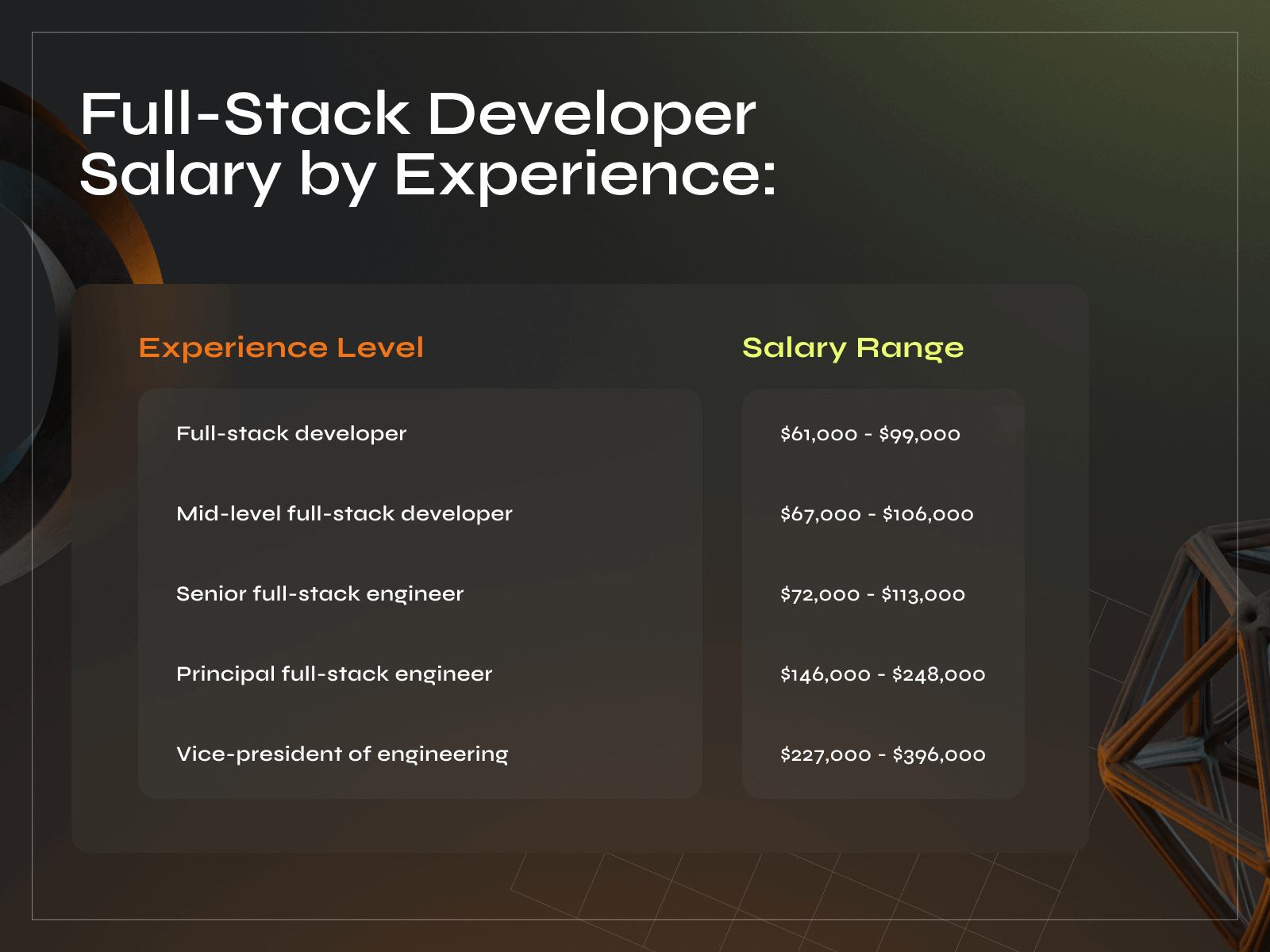Emerge into the world of full-stack development with our comprehensive guide. Explore the essential skills, educational pathways, and industry insights needed to become a successful full-stack developer.
Emerge into the world of full-stack development with our comprehensive guide. Explore the essential skills, educational pathways, and industry insights needed to become a successful full-stack developer.
Full-stack development has been a niche field for years, and its popularity continues to grow. A skilled full-stack developer is indispensable for complex projects, as their expertise can replace multiple front-end and back-end coders. They act as universal soldiers, adept at efficiently developing and maintaining solutions encompassing server-side and user-interface functionality. Keep reading to learn more about who a full-stack developer is, what skills are required to become one, and how much an experienced end-to-end developer will cost you.
How to Hire a Full Stack Developer: Understanding the Anatomy
Who is a full-stack developer, exactly? This expert possesses the background and skill set necessary to create end-to-end solutions in software development. A full stack web developer is proficient in both front-end and back-end, ensuring they can work on all software layers. The full stack developer works across the entire application, handling everything from user interfaces to server-side logic and databases. A stack web developer is a professional capable of handling both front-end and back-end development, making them highly versatile and efficient for a wide range of projects. And that’s not the end of it. Databases are the backbone of full-stack applications, storing and managing data efficiently. Developers must understand different database types, including SQL and NoSQL, and be proficient in database management systems like MySQL, MongoDB, or PostgreSQL. And let’s not forget about DevOps. As a full-stack developer, you’ll deploy front and back-end components, which is almost impossible without DevOps components like continuous integration and continuous deployment pipelines. Understanding deployment processes, including CI/CD pipelines and cloud platforms, is essential for automating software delivery and improving efficiency. Version control and version control systems, such as Git, GitHub, or GitLab, are also crucial for collaboration, code management, and seamless deployment. Now, let’s talk about building the user interface and the server-side functionality in greater detail.
Front-end development is just a small fraction of the entire development process. It focuses on crafting an excellent user interface and a smooth, uninterrupted experience. Developers utilize HTML for structure, CSS for styling, and JavaScript for interactivity. Frameworks like React, Angular, or Vue.js streamline development, enabling the creation of dynamic user interfaces and web experiences. Attention to UI/UX principles ensures appealing and intuitive navigation.
Back-end development powers an application’s server-side functionalities. It involves managing databases, processing requests, and generating responses. Developers use languages like Node.js, Python, or Ruby, alongside frameworks like Express.js, Django, or Flask, to build robust server-side components. Understanding databases, APIs, and server management is crucial for effective back-end development.
Testing is a big part of a full-stack developer’s expertise. It is imperative to validate the functionality and performance of full-stack applications. Developers employ testing techniques, including unit, integration, and end-to-end testing, using tools like Jest, Mocha, and Selenium. Timely debugging across front-end and back-end environments ensures quick issue resolution. Maintaining code quality through best practices, code reviews, and automation is essential for delivering reliable software.
Now, project management expertise is rarely considered. Popular methodologies like Scrum and Agile promote iterative development. Developers need to have at least a basic understanding of how project management tools work. One of the most commonly used ones is Jira. While quite complex and confusing, it is perfect for software development teams working on big and complex projects.
As a full-stack developer, you can choose from various stacks. The term tech stack refers to the combination of technologies, frameworks, programming languages, and tools used in a project. Defining your tech stack is important for attracting suitable developers and ensuring project requirements are met. While there are far more than three, these are some of the most common ones:
- LAMP Stack (Linux + Apache + MySQL + PHP): Widely embraced for web service stacks, this model remains a prevalent choice.
- MERN Stack (MongoDB + Express + React + Node.js): This stack, comprising JavaScript-based technologies, is a favorite option for web application development.
- MEAN Stack (MongoDB + Express + Angular.js + Node.js): Noteworthy for its rising popularity, the MEAN stack offers a comprehensive set of tools, particularly for modern web development projects.
Introduction to Full-Stack Development
Full-stack development represents a holistic approach to software development, where a single professional or team is equipped to handle both the front-end and back-end of web applications. A full stack developer is adept at working with a variety of programming languages, frameworks, and tools, allowing them to build, maintain, and optimize every layer of a digital product. This versatility means stack developers can oversee the entire development process, from crafting engaging user interfaces to implementing robust server side development. As businesses increasingly seek to streamline workflows and accelerate project timelines, hiring full stack developers has become a strategic move. By leveraging the expertise of full stack developers, companies can ensure seamless integration across both the front end and back end, resulting in more efficient software development and higher-quality web applications.
Role of a Full-Stack Developer
Full-stack development represents a holistic approach to software development, where a single professional or team is equipped to handle both the front-end and back-end of web applications. A full stack developer is adept at working with a variety of programming languages, frameworks, and tools, allowing them to build, maintain, and optimize every layer of a digital product. This versatility means stack developers can oversee the entire development process, from crafting engaging user interfaces to implementing robust server side development. As businesses increasingly seek to streamline workflows and accelerate project timelines, hiring full stack developers has become a strategic move. By leveraging the expertise of full stack developers, companies can ensure seamless integration across both the front end and back end, resulting in more efficient software development and higher-quality web applications.

Read also: Navigating the Benefits and Risks of Outsourcing App Development for App Owners
Front-End Essentials
1. User Interface (UI) Design: Full-stack developers’ responsibilities involve creating the visual elements of a website or web application. These include designing layouts, selecting color schemes, and ensuring a user-friendly experience.
2. HTML/CSS/JavaScript: Proficiency in these core technologies is crucial for full-stack development. HTML (HyperText Markup Language) provides the structure of web pages, CSS (Cascading Style Sheets) dictates the presentation and styling, and JavaScript adds interactivity and dynamic behavior to web pages.
3. Frameworks and Libraries: Developers often work with frameworks and libraries to streamline development and enhance functionality. Popular frameworks like React.js, Angular, and Vue.js offer reusable components and efficient state management, while libraries like jQuery simplify DOM manipulation and event handling.
4. Responsive Design: With the proliferation of mobile devices, full-stack developers must ensure that websites and applications are responsive and adaptable to various screen sizes and resolutions. Responsive design principles, including flexible layouts and media queries, are essential for creating a seamless user experience across devices.
5. Accessibility: Full-stack developers should consider accessibility standards and guidelines to ensure websites and applications are usable by people with disabilities. This includes providing alternative text for images, using semantic HTML markup, and implementing keyboard navigation and focus management.
Back-End Essentials
- Server-Side Programming Languages: Full-stack developers work with server-side programming languages to handle data processing, business logic, and server-side rendering. Proficiency in back end technologies is a key area of expertise for full-stack developers. Common languages include Node.js (JavaScript), Python, Ruby, PHP, and Java.
- Frameworks and Middleware: Full-stack developers often leverage frameworks and middleware to expedite development and streamline common tasks. Frameworks like Express.js (for Node.js), Django (for Python), Ruby on Rails, and Laravel (for PHP) provide pre-built components and MVC (Model-View-Controller) architecture for developing easy-to-scale and maintain applications.
- Database Management: Full-stack developers use databases to store, retrieve, and manipulate data. They should be familiar with relational databases (e.g., MySQL, PostgreSQL) and NoSQL databases (e.g., MongoDB, Firebase), database management systems, and query languages. The ability to write efficient queries is essential for optimizing database performance and ensuring fast, reliable access to data.
- API Development: The design and implementation of APIs (Application Programming Interfaces) are vital to enabling communication between software application components or multiple applications. APIs define endpoints, specify request and response formats, and handle authentication and authorization.
- Security: Finally, back-end architects typically implement security measures to protect the product from the most common web vulnerabilities, such as SQL injection, cross-site scripting (XSS), and cross-site request forgery (CSRF). They employ input validation, parameterized queries, and encryption techniques to safeguard sensitive data and ensure the application’s integrity.
Full-stack developers are also responsible for understanding server infrastructure to support application deployment and scaling. Additionally, content management systems are often used in projects like e-commerce platforms and social networks, highlighting the need for full-stack expertise.
Related: Flutter vs React Native – Which is Better for Your Project?
Stack Developers and Cloud Platforms
In today’s digital landscape, full stack developers frequently leverage cloud platforms to build scalable and resilient web applications. Cloud platforms such as Amazon Web Services (AWS), Microsoft Azure, and Google Cloud Platform (GCP) provide essential services for computing, storage, and database management, enabling stack developers to deploy and manage applications efficiently. Experience with cloud platforms allows full stack developers to design solutions that are not only robust but also flexible enough to handle changing user demands. When hiring full stack developers, it’s important to consider their familiarity with cloud-based tools and their ability to integrate server side logic, manage databases, and create seamless user interfaces within these environments. This expertise ensures that web applications are secure, scalable, and optimized for performance across the entire stack.
Career Opportunities
Companies seek web developers capable of managing the entire stack in product creation. Stack Overflow projects a 27% growth in employment by 2024, and full-stack developers, including experienced full stack developers, will be in high demand, offering ample opportunities for comprehensive work. The value of hiring an experienced full stack developer lies in their proven expertise across both front-end and back-end technologies.
As versatile professionals, full stack engineers—also known as full stack programmers or stack programmers—enjoy diverse pathways for career advancement, whether within international tech giants or leading domestic IT firms, where they can carve out successful careers and command higher salaries. For instance, a senior full stack developer can take on leadership and mentorship roles, guiding teams and junior full stack developers, while senior developers leverage their broader technical expertise to lead projects or mentor staff. Entry-level positions often include junior full stack developer roles, where typical responsibilities involve supporting both front-end and back-end tasks under supervision.
Moreover, extensive experience in full-stack development equips specialists with the skills needed to transition into roles in architecture or management, or even move into a software engineer position focused on designing complex systems. Some have even used their expertise to launch successful startups, showcasing the field’s potential for innovation and entrepreneurship. Most full stack developers tend to specialize in either front-end or back-end over time, but the best full stack developers are adaptable and proactive in problem-solving, enabling them to excel in a variety of roles and business contexts.
Global Talent in Full-Stack Development
The search for skilled full stack developers has become a global endeavor, with companies tapping into international talent pools to find the right expertise. By hiring full stack developers from around the world, organizations can access a diverse range of skills, experiences, and perspectives that drive innovation. However, building a development team with global talent requires careful consideration of factors such as time zone differences, language proficiency, and cultural fit. Utilizing specialized platforms and recruitment agencies can help companies identify and hire top full stack developers, ensuring they assemble a team capable of tackling complex projects. Embracing global talent not only broadens the pool of available stack developers but also enhances the overall capabilities and creativity of the development team.
Benefits of Hiring Full Stack Developers
Hiring full stack developers offers a multitude of advantages for companies aiming to optimize their development process. These professionals are equipped to handle multiple aspects of web applications, from designing user interfaces to managing server side logic and databases. Their ability to work across the entire stack reduces the need for specialized developers, streamlining communication and collaboration within the team. Full stack developers can quickly identify and resolve issues, suggest improvements to the technical stack, and adapt to evolving project requirements. By hiring full stack developers, organizations can accelerate project timelines, reduce costs, and enhance the quality and scalability of their web applications, making them a smart investment for any forward-thinking business.
- Technical Knowledge Alone is Enough: Contrary to common belief, being a full-stack developer requires more than technical expertise. Full stack developer skills include both technical and soft skills, such as communication, teamwork, and adaptability. It entails working collaboratively with designers, testers, and product managers. Additionally, full-stack developers must possess planning, task estimation, time management, data analysis, and decision-making skills.
- Language Proficiency: People believe full-stack developers are simultaneously proficient in multiple programming languages. Their primary role does involve designing both the client and server-side components. However, proficiency in key frontend frameworks and one or two backend languages, typically centered around JavaScript, suffices for most tasks.
- Seniority Assumption: Not all full-stack developers are senior-level professionals. The level of expertise required depends on the project’s needs. There are various full stack developer roles, ranging from junior to senior, each with different responsibilities and expectations. For instance, a junior-grade position may suffice if basic proficiency in front and backend development is adequate to maintain the project.
- Uniform Skill Set: Full-stack developers possess a different skill set. Numerous stack options are available, and developers choose their stack based on project requirements and personal preferences. For example, one developer might prefer Python and Django, another opts for JavaScript and Node.js, and another chooses Ruby on Rails. Full stack web developers may select different technology stacks to best fit the unique needs of each project. Additionally, specialization plays a role; developers focused on mobile, web, or SaaS applications select stacks aligned with their professional interests.
When building a team, hiring dedicated full stack developers can provide flexibility and efficiency for specific projects, as they bring a broad range of expertise and can adapt to various development needs.

Salary Expectations
Like any other software development expert, the cheapest places to look for a tech-savvy full-stack developer are usually Eastern Europe, Latin America, India, and Southeast Asia. Salaries in Eastern Europe are generally lower compared to Western Europe or North America. Entry-level salaries for those in Eastern Europe may range from €20,000 to €40,000 annually, with mid-level and senior-level salaries increasing accordingly. Southeast Asia is also pretty cost-effective. Countries like India, the Philippines, and Vietnam have lower living costs and, thus, lower salary expectations than Western countries. Entry-level salaries may range from $10,000 to $20,000 annually, with mid-level and senior-level salaries increasing accordingly. Finally, countries like Mexico, Brazil, and Argentina in Latin America offer competitive wages for full-stack developers, with entry-level salaries ranging from $20,000 to $40,000 per year.
When considering salary data, it’s important to note that a full stack engineer can be hired for in-house, freelance, or remote work, and compensation may vary depending on the employment option and region. This flexibility makes the full stack engineer role highly valuable for workforce planning and strategic hiring.
But remember, these numbers depend on the specific technology stack, project type and complexity, and many other factors. Contact your software development partner to learn how much hiring a developer for your project will cost.

Full-Stack Development: Final Words
Hopefully, this article helped you understand more about what a full-stack developer does. If you want to learn more about software development or have already decided to hire a team, Phenomenon Studio is an experienced full-cycle design and development studio with a diverse portfolio and skilled experts. Contact us to begin a lucrative and fruitful collaboration that will transform your dream into a reality.
FAQs
Can a full-stack developer work on mobile apps?
Yes, a full-stack developer can work on mobile apps, especially with frameworks like React Native or Flutter that allow cross-platform development.
Is it better to specialize in front-end or back-end before going full-stack?
Specializing in either front-end or back-end before transitioning to full-stack depends on individual career goals and preferences; some find gaining expertise in one area beneficial before expanding their skill set.
What are the best communities and forums for full-stack developers?
Some of the best communities and forums for full-stack developers include Stack Overflow, GitHub, Reddit’s r/webdev and r/learnprogramming, and forums specific to technologies like Dev.to and Hashnode.













